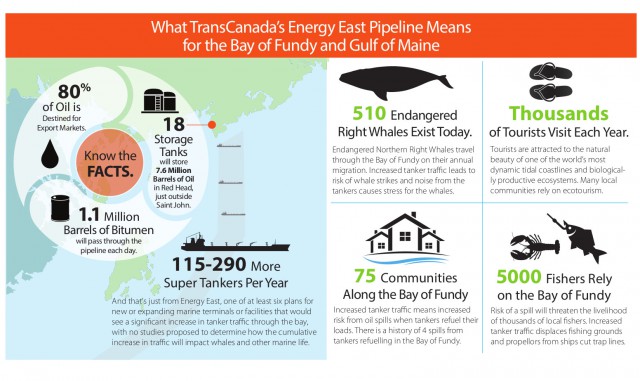
Over 75% of Energy East Pipeline Capacity Would be Exported out of Saint John
Dec. 17, Saint John — TransCanada’s revised Energy East pipeline application filed today would more than double the number of oil tankers carrying tar sands oil through the Bay of Fundy and down the coast of the United States from 115 to more than 280 per year. Meanwhile, more than 75 per cent of the total pipeline capacity – or more than 800,000 barrels per day – would be exported out of one marine terminal, in Saint John.
“TransCanada’s new application puts much of the burden of what would be North America’s longest oil pipeline on New Brunswick, Nova Scotia and Maine,” said Matthew Abbott of the Conservation Council of New Brunswick. “The Energy East pipeline threatens the Bay of Fundy, an important and iconic natural area and source of jobs for coastal residents in New Brunswick, Nova Scotia, and Maine.”
The new Saint John terminal would have an oil storage capacity of 13.2 million barrels, up from the initial 7.65 million barrels, while the new oil storage tanks needed to handle these volumes would reach the height of six-story buildings.
“TransCanada’s revised application would see a massive amount of tar sands oil shipped daily through the most productive and biodiverse waters on the East Coast,” said Joshua Axelrod, a policy analyst with the U.S.-based Natural Resources Defense Council. “For people up and down the U.S. east coast, today is the day to start paying attention. Not only does this project and its hundreds of oil supertankers place the coast of Maine at risk from a tar sands oil spill, it places coastlines in Massachusetts, New York, Maryland, Delaware, Florida, and much of the Gulf Coast at major risk.”
On top of these already major concerns, the National Academy of Sciences (NAS), the primary scientific advisor to the U.S. Congress, released a report last week that found dilbit often quickly sinks if spilled into water—as already witnessed in the Kalamazoo River in 2010—but also that first responders, governments, and industry are unprepared and lack the knowledge or technology to remediate a tar sands oil spill in water.
“As people in New Brunswick learn more about the Energy East project, they are filling town hall meetings and protesting like in Quebec,” said Lynaya Astephen of the Red Head Anthony’s Cove Preservation Association. “When I first heard about this project it felt very lonely expressing my concern, but now my community has organized and I am working with like-minded people from all along this pipeline route.”
While Energy East would create a small number of long term jobs at great environmental risk, there are an estimated 5,000 people working in fisheries on the New Brunswick side of the Bay of Fundy, and that doesn’t include people working in tourism. A bitumen spill in the Bay of Fundy could put all these jobs at risk. Meanwhile, across the border, the impact of more than a century of commercial fishing, industrial activity, and accelerating climate change is stressing the Gulf of Maine’s ecological survival just as TransCanada is proposing to load these waters with tankers carrying millions of gallons of tar sands oil.
“The people of Maine have clearly shown their opposition to tar sands oil. The proposed Energy East pipeline by TransCanada, the same company behind the rejected Keystone XL pipeline, would hug the boundary of Maine. This would effectively surround our state with an unacceptable risk. The Gulf of Maine, vital to our economy, is already threatened enough without tankers carrying tar sands oil through our waters,” said Bob Klotz of 350 Maine, speaking also for Environment Maine, Food and Water Watch-Maine, Natural Resources Council of Maine, Protect South Portland, Sierra Club-Maine
TransCanada’s selection of Saint John as the sole export terminal poses real risks to the many animals that call the Bay of Fundy and Gulf of Maine home, including the endangered North Atlantic right whale and up to seven other whale species. Energy East will significantly increase threats facing the Bay of Fundy’s many whales from noise, ship strikes, and oil spills caused by existing industrial activity in the Bay of Fundy and Gulf of Maine.
Read more about impacts to the Bay of Fundy and Gulf of Maine here.
-30-
For more information, please contact:
Matthew Abbott, Conservation Council of New Brunswick, (506) 321-0429
Joshua Axelrod, policy analyst with Natural Resources Defense Council (202) 289-2379
Lynaya Astephen, Red Head resident (506) 653-7959

